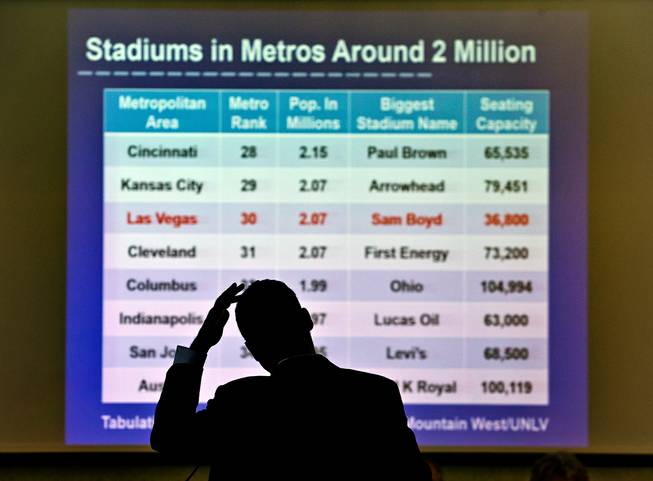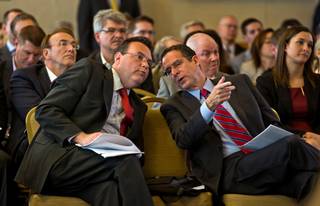
Robert Lang of Brookings Mountain West speaks during the Southern Nevada Tourism Infrastructure Committee meeting Thursday, March 24, 2016, at UNLV to hear about plans backed by Las Vegas Sands for a 65,000-seat football stadium.
Published Thursday, March 24, 2016 | 10:30 a.m.
Updated Thursday, March 24, 2016 | 4:54 p.m.
More Coverage
Las Vegas Sands Corp. and Majestic Realty Co. publicly aired their plans Thursday for a new 65,000-seat football stadium by the UNLV campus, describing to a key infrastructure panel how Las Vegas would benefit from the facility and its potential for attracting an NFL team.
The presentation to the Southern Nevada Tourism Infrastructure Committee envisioned a project that would cost an estimated $1.3 billion and require some public funding. If approved, construction could start in late 2017 and the stadium could open in the second half of 2020, according to Majestic Realty executive Craig Cavileer, who is also president of the Silverton casino.
The stadium would likely be built on a 42-acre parcel of land recently purchased by UNLV along Tropicana Avenue near Koval Lane. Backers would want the state Legislature this summer to create a stadium authority board with power to execute the project, Cavileer said, as well as authorize a “reliable source of public revenue” to cover “a portion” of the project’s price tag.
Early reports pegged the public share of the stadium cost at $780 million, which would likely come from tourism taxes, but Cavileer did not commit to a specific figure. He indicated that would be clarified at a future appearance before the infrastructure committee.
Much of the meeting focused on why the stadium was even necessary and what effect it could have on Southern Nevada. Presenters sought to educate the committee about interest in the stadium, its potential economic impact and how similar facilities were developed in other markets.
Cavileer told the panel that Las Vegas and the state of Nevada should make “strategic investments” that provide immediate returns on investment and benefit the tourism economy. Despite calling itself the entertainment capital of the world, the area is lacking without a larger stadium that can fit more visitors at once, he said.
“A multipurpose stadium puts Las Vegas on the map in a much different way than today,” Cavlieer said.
He cast the stadium as a way to meet both the needs of UNLV — which wants to bring its football team to a venue closer to campus — and the tourism industry.
The facility could at least host UNLV football games and a range of large entertainment and sporting events. But the biggest potential use would be to house an NFL team such as the Raiders, whose owner, Mark Davis, has recently met with Las Vegas Sands CEO Sheldon Adelson and Gov. Brian Sandoval.
UNLV President Len Jessup said building a stadium would be a “game-changer” for UNLV and could help further the university’s goal of becoming an elite institution.
“Where we want to go as a top-tier university involves not only improvements on the academic side of the house...but it also requires us to make improvements on the athletic side of the house,” Jessup said.
Proponents also attempted to show the committee how the stadium proposal would benefit the region more generally — with or without an NFL team.
If the stadium hosts an NFL team, sponsorship revenue, including naming rights and other sources, could generate $26.4 million in revenue by 2019, consultants for the project found. That figure was only $8 million for a non-NFL stadium, according to a presentation from Convention, Sports & Leisure International.
Even without an NFL team, however, a large stadium could generate sizable benefits in other areas. Fifteen non-NFL events in such a venue could produce $46 million a year in tax revenue, according to Mark Rosentraub, a University of Michigan professor who analyzed the project’s economic potential.
Though the infrastructure committee has not yet examined which public funding sources the stadium would need, Clark County hotel room taxes are a potential source. And that possibility has already clashed with another big infrastructure project: the $1.4 billion expansion and renovation of the Las
Vegas Convention Center.
Las Vegas Sands has argued the convention center expansion should not be publicly funded, saying it competes with the private sector. But MGM Resorts International has said room taxes should not be diverted to the stadium from the convention center project.
Conflicting polls released yesterday attempted to bolster the case for which facility Nevadans wanted more.
Global Strategy Group, in a poll funded by MGM Resorts, said it found that a “commanding majority” of Nevadans supported using room tax revenues to fund the expansion and renovation of the convention center.
On the other side, Morning Consult touted results of a poll conducted on behalf of Las Vegas Sands that said an “overwhelming majority” of Nevadans backed plans for a retractable-roof stadium and the idea of relocating an NFL team to the Las Vegas area.
In other related news, NFL Commissioner Roger Goodell said Tuesday that if the Raiders were willing to move to Las Vegas and the league’s owners were supportive of the relocation, he likely wouldn’t interfere.
“Ultimately, it’s the ownership’s decision,” Goodell said on the Rich Eisen Show. “It requires 24 of the 32 owners to approve any relocation to any market.”
Sands President Rob Goldstein told the infrastructure committee that the proposed stadium has a real shot at attracting an NFL team, and that his company was committed to trying to make it happen.
But stadium supporters still appear ready to proceed with or without an NFL team. And MGM Resorts President Bill Hornbuckle, a member of the committee, was skeptical today that the stadium would really draw in a significant number of other events that Las Vegas could not attract anyway.
Rosemary Vassiliadis, director of aviation at McCarran International Airport, brought up another concern: namely, the site’s proximity to the airport, which she said raises various issues with the Federal Aviation Administration that will need to be taken into account. Vassiliadis does not sit on the committee but serves as a technical advisor.
The infrastructure committee did not make any final decisions today, but should discuss it in more detail at the panel’s meeting next month.


Join the Discussion:
Check this out for a full explanation of our conversion to the LiveFyre commenting system and instructions on how to sign up for an account.
Full comments policy